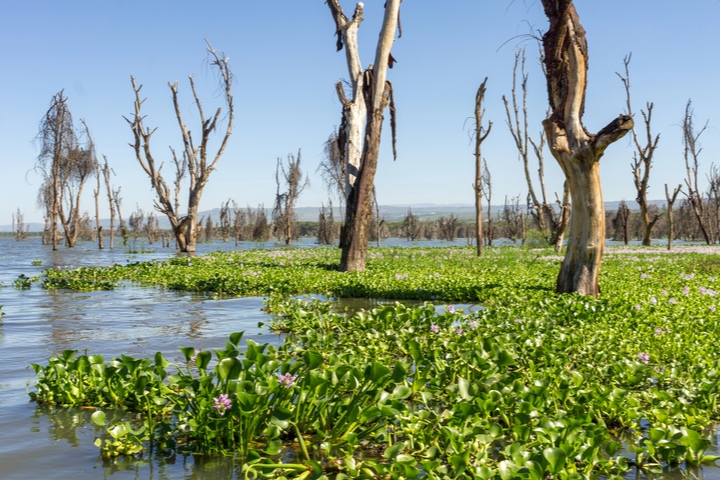PLASTIC FANTASTIC
A new idea is planted
— By Dede Williams —
The pesky things blanket the lake’s surface, choke fish, cut off oxygen and sunlight, and clog hydroelectric and irrigation systems. The impact on biodiversity and the livelihoods of fishermen is catastrophic.
The pesky things blanket the lake’s surface, choke fish, cut off oxygen and sunlight, and clog hydroelectric and irrigation systems. The impact on biodiversity and the livelihoods of fishermen is catastrophic.
 Water hyacinth creeps further into Kenya’s Lake Naivasha, located between Nairobi and Nakuru (Photo: PantherMedia/derejeb) |
With their explosive growth now costing the global economy more than around EUR 675 mn annually, the menace presented by water hyacinth in Africa alone rivals without diminishing that of single-use plastics, says the Intergovernmental Science-Policy Platform on Biodiversity and Ecosystem Services (IPBES) of the UN Environment Programme.
As no high-tech vessels like those deployed by The Ocean Cleanup have yet lowered the boom on Kenya’s Lake Naivasha, and recycling invasive plants capable of multiplying almost anywhere is hardly an option, unique solutions are needed.
Hyacinths to bioplastics
Kenyan start-up HyaPak (Nakuru; www.hyapak.com) has a simple formula for solving both the plastic and plant crises: convert hyacinths into carrier bags. Mix the dried blossom with binders and additives and the job is done.
As company founder Joseph Nguthiru explains, the idea requires a shift in semantics, as Kenya has banned single-use plastics, but not really a problem, as most of the biobags will degrade within 10 minutes of leaving supermarket shelves.
Related: Aimplas to investigate algae-to-plastics potential as part of Ruguplas initiative
Nguthiru, who has received awards for his concept, is now thinking of using HyaPak’s products in a flagship Kenyan reforestation scheme that aims to plant 15 bn seedlings by 2032.
The seedlings will need bags to grow and be transported in, and HyaPak’s know-how, along with the plants that fishermen will eagerly supply, could fill the bill. A bioplastic seedling bag with a carbon footprint of 1.6-1.7 kg, together with nutrients, should offset the carbon emissions produced.
HyaPak is already exporting to the US and Germany and plans are to establish franchises in India and El Salvador – two countries with freshwater blighted by water hyacinth.
As company founder Joseph Nguthiru explains, the idea requires a shift in semantics, as Kenya has banned single-use plastics, but not really a problem, as most of the biobags will degrade within 10 minutes of leaving supermarket shelves.
Related: Aimplas to investigate algae-to-plastics potential as part of Ruguplas initiative
Nguthiru, who has received awards for his concept, is now thinking of using HyaPak’s products in a flagship Kenyan reforestation scheme that aims to plant 15 bn seedlings by 2032.
The seedlings will need bags to grow and be transported in, and HyaPak’s know-how, along with the plants that fishermen will eagerly supply, could fill the bill. A bioplastic seedling bag with a carbon footprint of 1.6-1.7 kg, together with nutrients, should offset the carbon emissions produced.
HyaPak is already exporting to the US and Germany and plans are to establish franchises in India and El Salvador – two countries with freshwater blighted by water hyacinth.
24.01.2025 Plasteurope.com [257079-0]
Published on 24.01.2025
